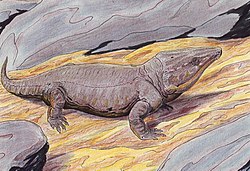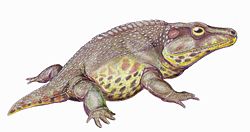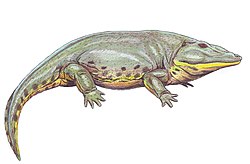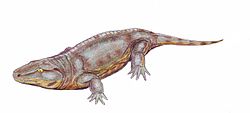Top Qs
Timeline
Chat
Perspective
Vale Formation
Geologic formation in Texas, United States From Wikipedia, the free encyclopedia
Remove ads
The Vale Formation is a geological formation in north-central Texas, a component of the Texas red beds preserving sediments and fossils from the Early Permian Leonardian series. It occupies the middle part of the Clear Fork Group, above the Arroyo Formation and below the Choza Formation.[1] Some sources consider the Vale Formation to be merely an informal subunit of the Clear Fork Formation, thus renaming it to the Middle Clear Fork Formation.[2]
Remove ads
Geology
Summarize
Perspective
The Vale Formation is named after a former post office in the vicinity of Ballinger in Runnels County.[1] At its broadest conception, the Vale Formation is a unit of primarily terrestrial sediments up to 160 metres (520 ft) thick,[2] stretching from the Texas-Oklahoma border at Wilbarger County, as far south as Runnels County. The base of the Vale Formation is marked by either a limestone bed (the Standpipe Limestone, south of Abilene), or in some northern areas, a sharp unconformity. Likewise, its contact with the Choza Formation is marked by the base of the Bullwagon Dolomite, which is most well-exposed south of Haskell, or by evaporite beds in northern exposures such as Knox County.[3][1]
Limestone is rare in the fully terrestrial northern red beds, complicating the distinction between the three formations of the Clear Fork Group.[3] To resolve this problem, some geologists, like Nelson et al. (2013), consider the northern part of the Clear Fork Group to be a single formation divided into three informal subunits.[2] In the northern area, major sandstone beds are the most useful stratigraphic markers for distinguishing these informal subunits. The Middle Clear Fork Formation extends from the base of the Brushy Creek Sandstone to the base of the Rt. 1919 Sandstone. Another major sandstone bed, the Cedar Top Sandstone, occurs between these two levels.[2]
As with much of the Texas red beds, the dominant sediments (around 80% by volume) are fine-grained red floodplain deposits such as mudstones, clays, shales, siltstones, and paleosols. Localized beds and lenses of sandstone and conglomerate recorded active meandering river channels, abandoned channels (such as oxbow lakes), and crevasse splays.[3][1][4][2][5][6] The conglomerates of the Vale Formation occur in two distinct forms, either large light-colored fragments or (particularly in the northern area) dark brown pebbles derived from the surrounding clay.[3][7] Light even-bedded clay (pond deposits) may occasionally be found.[3][1][2][8]
Though quite fossiliferous, the fossils of the Vale Formation have not been studied as long as older parts of the Texas red beds, some of which have been prospected since the 1870s. Geologists of the University of Texas discovered the first fossils from the Vale Formation in the 1930s, at the Sid McAdams locality in Taylor County.[9][1] Since 1946, many more finds were recovered from Knox, Baylor, and Foard counties under the direction of University of Chicago paleontologist Everett C. Olson, who described the northern Vale fossil fauna in detail over the course of the 1950s.[10][3][1] Other notable sites include the Stamford locality in Haskell County (discovered by Dalquest and Maymay in 1963),[11][1] the Blackwood locality in Taylor County (discovered by David Berman in 1970),[1] and the Mud Hill locality (described by Bryan Gee et al. in 2018), also in Taylor County.[12] Over 60 small fossil sites are scattered south of the Clear Fork of the Brazos River.[1]
Remove ads
Paleobiota
Summarize
Perspective
Synapsids
Reptiles
The largest true reptile known from the Vale Formation is an indeterminate moradisaurine captorhinid represented by an enormous tooth plate, at least 11.6 centimetres (4.6 in) in length.[22] This tooth plate was so large it was originally considered to be from an unnamed species of edaphosaurid, which would have made it the youngest known member of that family.[23] As a moradisaurine fossil, it corresponds to a skull around 35 centimetres (14 in) long, larger than Labidosaurikos meachami but smaller than Moradisaurus grandis.[22]
Amphibians
An indeterminate hapsidopareiid microsaur is known from the Mud Hill locality. It is potentially one of the youngest known microsaurs, apart from a few rhynchonkids known from Choza-equivalent strata near Norman, Oklahoma.[12]
Fish
Invertebrates
A few invertebrate fossils are known from the Sid McAdams locality. These include freshwater bivalves (?Palaenodonta) and a single well-preserved pygocephalomorph crustacean, Mamayocaris jespeni, a species which is abundant in Permian sediments of South Dakota.[1]
Plants
Plant fossils of the middle Clear Fork are most well-preserved in fine-grained abandoned river channel deposits.[4] Some abandoned channel sites are dominated by walchian conifers, Taeniopteris, and "comioid" peltasperms (Auritifolia).[8] Others have a high proportion of woody gigantopterids (Evolsonia), Taeniopteris, and marattialean tree ferns.[6] Tree ferns were probably most specialized for swampy areas alongside permanent water, while conifers occupied dry uplands. Peltasperms and gigantopterids were accustomed to intermediate conditions: well-drained soils with a high water table.[8][6] A diverse array of insect damage is reported from leaf fossils, with particular preference towards Auritifolia and Taniopteris.[44]
Remove ads
See also
References
Wikiwand - on
Seamless Wikipedia browsing. On steroids.
Remove ads














